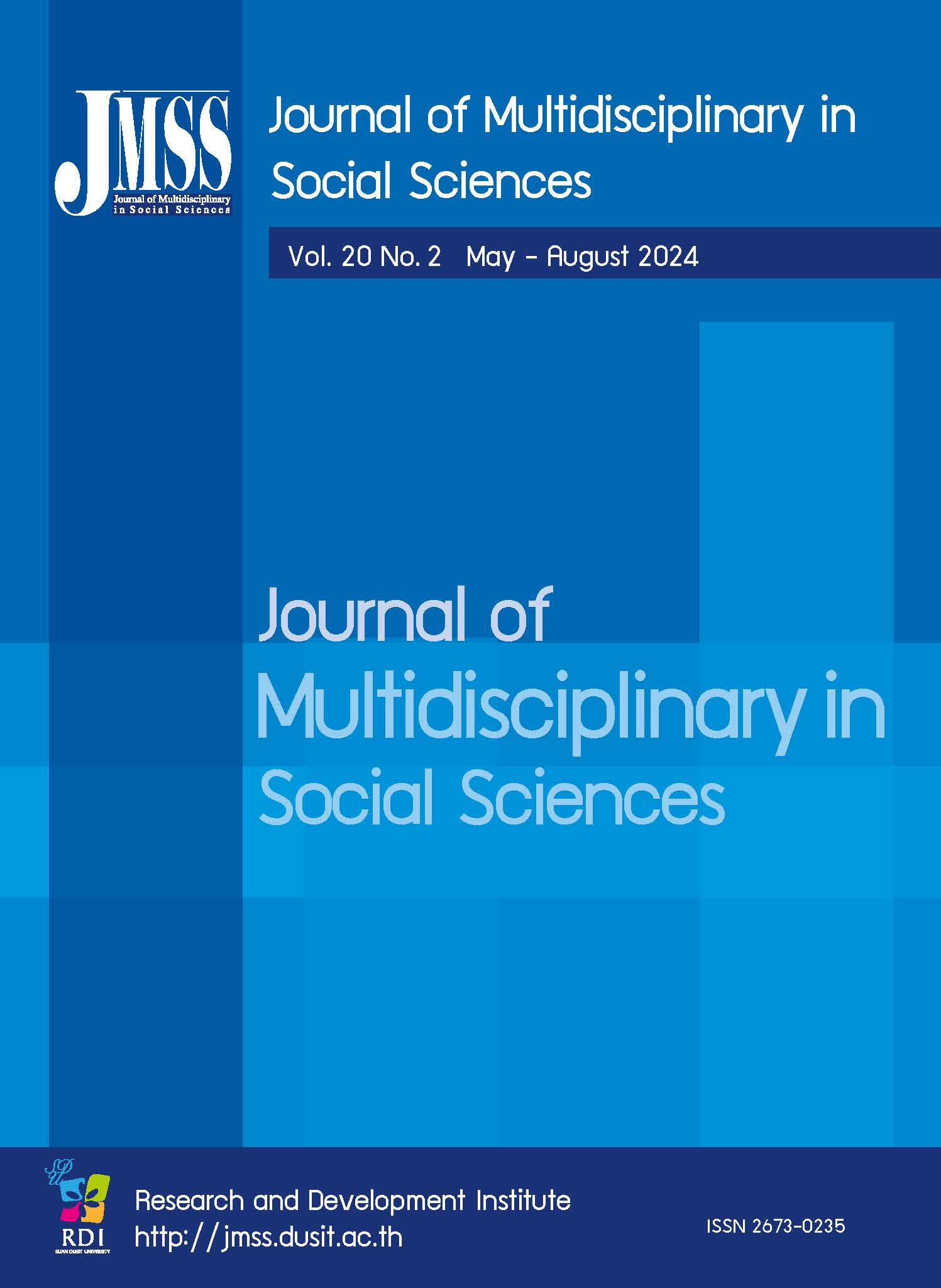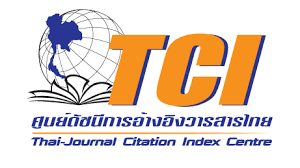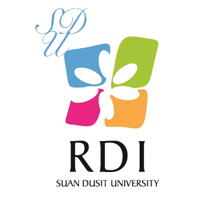Exploring the Impacts of Online Chat on Well-Being and Job Engagement in a Higher Education Work Environment
Keywords:
Online chat, Well-being, Job engagement, Thailand, Higher educationAbstract
Despite extensive research into the impacts of digital communication on well-being and job engagement, the specific effects of online chatting within these domains have been less explored, particularly in the context of Thailand's higher education sector. This quantitative study investigates the implications of online chatting on well-being and job engagement among 126 university lecturers in Thailand, with a demographic breakdown of 61.9% female and 37.3% male participants. Utilizing Partial Least Squares Structural Equation Modeling (PLS-SEM), the research examines three hypotheses: the impact of online chat on well-being (H1), online chat on job engagement (H2), and well-being on job engagement (H3). The findings reveal a significant negative impact of online chat on well-being (β = -0.236, p = 0.003), while the relationship between online chat and job engagement was not supported (β = -0.047, p = 0.642). Conversely, a strong positive relationship was observed between well-being and job engagement (β = 0.609, p < 0.001), underscoring well-being as a significant mediator between online chat and job engagement. These results highlight the nuanced role of online chat in the academic work environment, suggesting that while it may pose challenges to well-being, it also has the potential to indirectly enhance job engagement through improved well-being. The study's focus on a specific academic context and its reliance on self-reported data suggest caution in generalizing the findings, pointing to avenues for future research in broader demographic and occupational settings.
References
Abeele, M. V., De Wolf, R., & Ling, R. (2018). Mobile media and social space: How anytime, anyplace connectivity structures everyday life. Media and Communication, 6(2), 5-14.
Adisa, T.A., Ogbonnaya, C. and Adekoya, O.D. (2023). Remote working and employee engagement: a qualitative study of British workers during the pandemic. Information Technology and People, Vol. 13, pp. 1835-1850.
Alagaraja, M. (2020). Wellbeing in the workplace: A new conceptual model and implications for practice. The Palgrave Handbook of Workplace Well-Being, 1-22.
Alalwan, N. (2022). Actual use of social media for engagement to enhance students' learning. Education and Information Technologies, 27(7), 9767-9789.
Albrecht, S. L., Furlong, S., & Leiter, M. P. (2023). The psychological conditions for employee engagement in organizational change: Test of a change engagement model. Frontiers in Psychology, 14, 18.
Aldabbas, H., Pinnington, A., & Lahrech, A. (2023). The influence of perceived organizational support on employee creativity: The mediating role of work engagement. Current Psychology, 42(8), 6501-6515.
Almost, J., Wolff, A., Mildon, B., Price, S., Godfrey, C., Robinson, S., ... & Mercado-Mallari, S. (2015). Positive and negative behaviours in workplace relationships: a scoping review protocol. BMJ open, 5(2), e007685.
Awan, A., & Atta, A. (2023). Impact of Online Chat Language on Second Language Learners' written composition: A Corpus Based-Study. Global Language Review, VIII.
Baticulon, R. E., Sy, J. J., Alberto, N. R. I., Baron, M. B. C., Mabulay, R. E. C., Rizada, L. G. T., ... & Reyes, J. C. B. (2021). Barriers to online learning in the time of COVID-19: A national survey of medical students in the Philippines. Medical science educator, 31, 615-626.
Beer, P., & Mulder, R. H. (2020). The effects of technological developments on work and their implications for continuous vocational education and training: A systematic review. Frontiers in psychology, 11, 918.
Büchi M., Festic N., Latzer M. (2019). Digital overuse and subjective well-being in a digitized society. Social Media + Society, 5(4), 1–12.
Carmines, E. G., & Zeller, R. A. (1979). Reliability and Validity Assessment (Vol. 17). Thousand Oaks, CA: Sage.
Chaknum, P., Harniratisai, T., Somprasert, C., & Chiang, L. C. (2023). Perception of the factors contributing to family happiness among caregivers of stroke survivors in a suburban community in Thailand: A qualitative study. Malaysian family physician: the official journal of the Academy of Family Physicians of Malaysia, 18, 13.
Dijkstra, T.K. & Henseler, J. (2015) Consistent partial least squares path modeling. MIS Quarterly, 39, 297-316. https://doi.org/10.25300/MISQ/2015/39.2.02
Duke É., Montag C. (2017). Smartphone addiction, daily interruptions and self-reported productivity. Addictive Behaviors Reports, 6, 90–95. doi:10.1016/j.abrep.2017.07.002
Eldor, L. & Harpaz, I. (2016) A process model of employee engagement: the learning climate and its relationship with extra-role performance behaviors, Journal of Organizational Behavior, 37, 213– 235. https://doi.org/10.1002/job.2037
Feng, Y. K., Lu, X., & Zhang, X. M. (2021). Mutual Disclosures and Content Intimacy in Customer Group Engagement: Evidence from Online Chat Groups. Xianghua and Zhang, Xiaoquan (Michael), Mutual Disclosures and Content Intimacy in Customer Group Engagement: Evidence from Online Chat Groups (March 25, 2021). http://dx.doi.org/10.2139/ssrn.3812055
Fernandez-Portero, C., Amian, J. G., Alarcón, D., Arenilla Villalba, M. J., & Sánchez-Medina, J. A. (2023, January). The effect of social relationships on the well-being and happiness of older adults living alone or with relatives. Healthcare, 11(2), 222.
Fornell, C., & Larcker, D. F. (1981). Evaluating structural equation models with unobservable variables and measurement error. Journal of marketing research, 18(1), 39-50.
Franco, M., & Haase, H. (2012). A comparative study of cooperative relationships in family and non-family businesses. African Journal of Business Management, 6(44),
Garrick, A., Mak, A. S., Cathcart, S., Winwood, P. C., Bakker, A. B., & Lushington, K. (2018). Non‐work time activities predicting teachers’ work‐related fatigue and engagement: An effort‐recovery approach. Australian Psychologist, 53(3), 243-252.
Giles, S., Fletcher, D., Arnold, R., Ashfield, A., & Harrison, J. (2020). Measuring well-being in sport performers: Where are we now and how do we progress?. Sports Medicine, 50, 1255-1270. https://doi.org/10.1007/s40279-020-01274-z
Hair, J., Hult, G., Ringle, C., & Sarstedt, M. (2017). A primer on partial least squares structural equation modeling (PLS-SEM). Thousand Oaks, CA: Sage.
Hair, J., Risher, J., Sarstedt, M., & Ringle, C. (2019). When to use and how to report the results of PLS-SEM. European Business Review, 31(1), 2-24.
Hair, J.F., Black, W.C., Babin, B.J. and Anderson, R.E. (2010). Multivariate Data Analysis. 7th Edition, New York: Pearson,.
Hanssen, N., & Sundström, J. (2022). Digital communication in the sales process: The influence of digital communication and the rationale behind using it. Retrieved August 10, 2023 from https://urn.kb.se/resolve?urn=urn:nbn:se:umu:diva-197385
Henseler, J., Ringle, C. M., & Sarstedt, M. (2015). A New Criterion for Assessing Discriminant Validity in Variance-Based Structural Equation Modeling. Journal of the Academy of Marketing Science, 43, 115-135.
Hwang, M. Y., Hong, J. C., Tai, K. H., Chen, J. T., & Gouldthorp, T. (2020). The relationship between the online social anxiety, perceived information overload and fatigue, and job engagement of civil servant LINE users. Government Information Quarterly, 37(1), 101423.
International Labour Organization. (2021). Decent work. ILO. Retrieved August 10, 2023 from https://www.ilo.org/global/topics/decent-work/lang--en/index.htm
International Trade Union Confederation. (2018). Global poll: Governments’ failure to address low wages and insecure jobs threatens trust in politics and democracy. YouGov/ITUC. Retrieved August 10, 2023 from https://www.ituc-csi.org/ITUC-Global-Poll-2018
Ju, Y. C., & Paek, T. (2010). How to safely respond to SMS messages in automobiles. In Proceedings of the 2nd international workshop on Multimodal interfaces for automotive applications (pp. 8-8).
Khalid, J., Weng, Q.D., Luqman, A., Rasheed, M.I. and Hina, M. (2021). After-hours work-related technology use and individuals’ deviance: the role of other-initiated versus self-initiated interruptions. Information Technology and People, Vol. 35(7), 1955-1979.
Kock, N., & Hadaya, P. (2018). Minimum sample size estimation in PLS‐SEM: The inverse square root and gamma‐exponential methods. Information Systems Journal, 28(1), 227–261.
Kun, A., & Gadanecz, P. (2022). Workplace happiness, well-being and their relationship with psychological capital: A study of Hungarian teachers. Current Psychology: A Journal for Diverse Perspectives on Diverse Psychological Issues, 41(1), 185–199.
Kundi, Y. M., Aboramadan, M., Elhamalawi, E. M., & Shahid, S. (2021). Employee psychological well-being and job performance: exploring mediating and moderating mechanisms. International Journal of Organizational Analysis, 29(3), 736-754.
Lal, B., Dwivedi, Y. K., & Haag, M. (2023). Working from home during Covid-19: doing and managing technology-enabled social interaction with colleagues at a distance. Information Systems Frontiers, 25(4), 1333-1350.
Lanaj K., Johnson R. E., Barnes C. M. (2014). Beginning the workday yet already depleted? Consequences of late-night smartphone use and sleep. Organizational Behavior and Human Decision Processes, 124(1), 11–23.
Lau, D. C., Lam, L. W., & Wen, S. S. (2014). Examining the effects of feeling trusted by supervisors in the workplace: A self‐evaluative perspective. Journal of Organizational Behavior, 35(1), 112-127.
Lee, H. W., Kim, S., & Uhm, J. P. (2021). Social virtual reality (VR) involvement affects depression when social connectedness and self-esteem are low: a moderated mediation on well-being. Frontiers in Psychology, 12, 753019.
Lee, H., McNamara, T. K., Pitt‐Catsouphes, M., & Lee, J. (2014). Opportunities to improve skills and to teach and train others: employee outcomes in the U nited S tates and J apan. International Journal of Training and Development, 18(3), 204-222.
Lew, Z., Walther, J. B., Pang, A., & Shin, W. (2018). Interactivity in online chat: Conversational contingency and response latency in computer-mediated communication. Journal of Computer-Mediated Communication, 23(4), 201-221.
Liu, C., Zhou, S., & Bai, X. (2022). Intergenerational relationship quality, sense of loneliness, and attitude toward later life among aging Chinese adults in Hong Kong. Frontiers in Psychology, 13, 930857.
Malvaso, A., & Kang, W. (2022). The relationship between areas of life satisfaction, personality, and overall life satisfaction: An integrated account. Frontiers in psychology, 13, 894610.
Mannell, K. (2020). Plural and porous: Reconceptualizing the boundaries of mobile messaging group chats. Journal of Computer-Mediated Communication, 25(4), 274-290.
Matthes J., Karsay K., Schmuck D., Stevic A. (2020). “Too much to handle”: Impact of mobile social networking sites on information overload, depressive symptoms, and well-being. Computers in Human Behavior, 105, 1–11.
Mazzetti, G., Robledo, E., Vignoli, M., Topa, G., Guglielmi, D., & Schaufeli, W. B. (2023). Work engagement: A meta-analysis using the job demands-resources model. Psychological Reports, 126(3), 1069-1107.
Mazzetti, G., Robledo, E., Vignoli, M., Topa, G., Guglielmi, D., & Schaufeli, W. B. (2023). Work engagement: A meta-analysis using the job demands-resources model. Psychological Reports, 126(3), 1069-1107.
McDaniel B. T., Drouin M. (2019). Daily technology interruptions and emotional and relational well-being. Computers in Human Behavior, 99, 1–8.
Men, L. R., Qin, Y. S., & Jin, J. (2022). Fostering employee trust via effective supervisory communication during the COVID-19 pandemic: Through the lens of motivating language theory. International Journal of Business Communication, 59(2), 193-218.
Nguyen M. H. (2021). Managing social media use in an “always-on” society: Exploring digital wellbeing strategies that people Use to disconnect. Mass Communication and Society, 24(6), 795–817.
Ninaus, K., Diehl, S., & Terlutter, R. (2021). Employee perceptions of information and communication technologies in work life, perceived burnout, job satisfaction and the role of work-family balance. Journal of Business Research, 136, 652-666.
Oksanen, C. (2023). The impact of remote work on motivation in Finland. Retrieved from
Park, J. G., Sik Kim, J., Yoon, S.W. and Joo, B.-K. (2017), "The effects of empowering leadership on psychological well-being and job engagement: The mediating role of psychological capital", Leadership & Organization Development Journal, 38 (3), 350-367.
Paerata, K. (2023). The use of workplace instant messaging since COVID-19. Telematics and Informatics Reports, 10, 100063.
Peña-Sarrionandia, A., Mikolajczak, M., & Gross, J. J. (2015). Integrating emotion regulation and emotional intelligence traditions: a meta-analysis. Frontiers in psychology, 6, 160.
Rajapaksha, R. A., & Tilakasiri, K. K. (2020). Individual Factors of Employee Engagement in Organizational Performance. In Proceedings of the International Conference on Business & Information (ICBI).
Reverberi, E., Manzi, C., Van Laar, C., & Meeussen, L. (2022). The impact of poor work-life balance and unshared home responsibilities on work-gender identity integration. Self and Identity, 21(5), 588-607. https://doi.org/10.1080/15298868.2021.1914715
Rhoads, S. A., & Marsh, A. A. (2023). Doing Good and Feeling Good: Relationships Between Altruism and Well-being for Altruists, Beneficiaries, and Observers. In World Happiness Report 2023 (11th ed., Chapter 4). Sustainable Development Solutions Network.
Rizvanović, B., Zutshi, A., Grilo, A., & Nodehi, T. (2023). Linking the potentials of extended digital marketing impact and start-up growth: Developing a macro-dynamic framework of start-up growth drivers supported by digital marketing. Technological Forecasting and Social Change, 186, 122128
Sadaf, M., Mukhtar, U., Nemati, A. R., Yousaf, R., & Javed, W. (2022). Impact of organizational value system, perceived organizational support, and job satisfaction on organizational commitment. Journal of Entrepreneurship, Management, and Innovation, 4(1), 71-99. 1
Sadiq, I. Z. (2023). Lifestyle medicine as a modality for prevention and management of chronic diseases. Journal of Taibah University Medical Sciences, 18(5), 1115-1117.
Salazar, C. A. (2022). Emerging organizational culture from the benefits and drawbacks of Facebook messenger group chat trend in public schools. Jurnal Aplikasi Manajemen, 20(1), 1-11.
Santos, A., Roberto, M. S., Camilo, C., & Chambel, M. J. (2023). Information and communication technologies-assisted after-hours work: A systematic literature review and meta-analysis of the relationships with work–family/life management variables. Frontiers in Psychology, 14, 1101191.
Sato, K., Kuroda, S., & Owan, H. (2020). Mental health effects of long work hours, night and weekend work, and short rest periods. Social Science & Medicine, 246, 112774.
Satria, N., & Kustiawan, U. (2023). The role of job insecurity and high commitment work system on employee well being. Jurnal cafetaria, 4(1), 25-39.
Schnauber-Stockmann A., Meier A., Reinecke L. (2018). Procrastination out of habit? The role of impulsive versus reflective media selection in procrastinatory media use. Media Psychology, 21(4), 640–668.
Schoofs, L., Hornung, S., & Glaser, J. (2022). Prospective effects of social support on self-actualization at work–The mediating role of basic psychological need fulfillment. Acta psychologica, 228, 103649.
Setyawati, N. W., PG, D. S. W., & Rianto, M. R. (2022). Career development, motivation and promotion on employee performance. East Asian Journal of Multidisciplinary Research, 1(9), 1957-1970.
Shaito, F. (2019). Career development: An overview. Retrieved 10 August, 2023 from https://www. researchgate. net/publication/336812981. Research· October.
Stephens, K. K., & Harrison, M. A. (2017). Work as Opportunity and Problem When Trying to Impact Health and Risk. In Oxford Research Encyclopedia of Communication.
Sulphey, M. M. (2023). Workplace spirituality, self-compassion and mindfulness as antecedents of employee mental wellbeing. South Asian Journal of Business Studies, 12(2), 269-292.
UNESCO. (2022). Glossary: Information and communication technologies (ICT). Institute for Statistics. Retrieved 5 June, 2022 from https://uis.unesco.org/en/glossary-term/information-and-communication-technologies-ict.
Vorderer P., Hefner D., Reinecke L., Klimmt C. (2017). Permanently online, permanently connected: Living and communicating in a POPC world. London: Routledge.
Walden, J., Jung, E. H., & Westerman, C. Y. (2017). Employee communication, job engagement, and organizational commitment: A study of members of the Millennial Generation. Journal of public relations research, 29(2-3), 73-89.
Wöhrmann, A. M., Dilchert, N., & Michel, A. (2021). Working time flexibility and work-life balance. Zeitschrift für Arbeitswissenschaft, 75(1), 74-85.
Wong, G. Y. L., Kwok, R. C. W., Zhang, S., Lai, G. C. H., Li, Y., & Cheung, J. C. F. (2023). Exploring the consequence of information communication technology-enabled work during non-working hours: a stress perspective. Information Technology & People, (ahead-of-print).
Yao, J., Qiu, X., Yang, L., Han, X., & Li, Y. (2022). The relationship between work engagement and job performance: psychological capital as a moderating factor. Frontiers in psychology, 13, 729131.
Zhang, X., Ma, L., Xu, B., & Xu, F. (2019). How social media usage affects employees’ job satisfaction and turnover intention: An empirical study in China. Information & Management, 56(6), 103136.
Zhong, J., Chen, Y., Yan, J., & Luo, J. (2022). The mixed blessing of cyberloafing on innovation performance during the COVID-19 pandemic. Computers in human behavior, 126, 106982.
Downloads
Published
How to Cite
Issue
Section
License
Copyright (c) 2024 Journal of Multidisciplinary in Social Sciences

This work is licensed under a Creative Commons Attribution-NonCommercial-NoDerivatives 4.0 International License.








